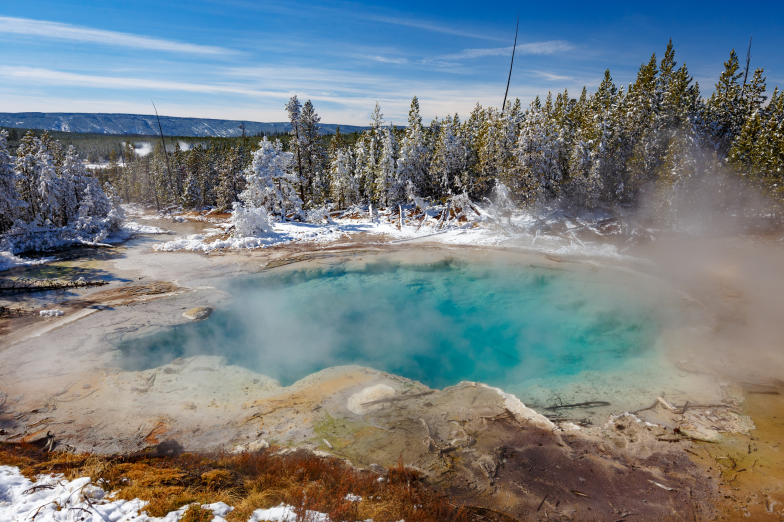America’s national parks attract over 310 million visitors annually, with most arriving in the warmer months. While many parks are definitely worth the summer crowds, a winter visit can offer a more peaceful experience, allowing you to enjoy activities and stunning sights in tranquility. After exploring numerous parks across the country, I’ve discovered that winter can be particularly enjoyable, whether you’re in the remote Olympic Peninsula in Washington, the iconic deserts of Joshua Tree in California, the rugged coast of Maine, or the alligator-filled wetlands of Florida.
Yosemite National Park, California
Yosemite in winter is truly magical, offering a stark contrast to the bustling summer months filled with visitors in Yosemite Valley and on the trails. During this season, you can marvel at snow-capped peaks and frozen waterfalls. With the hiking trails blanketed in snow, snowshoeing becomes a delightful option. Ice skating beneath the towering Half Dome is a memorable experience, especially with a fire pit nearby to warm up when the temperatures drop. Plus, Glacier Point/Badger Pass Road is plowed, making it easy to access the Badger Pass Ski Area for skiing, snowboarding, or snow tubing.
Rocky Mountain National Park, Colorado
Colorado is well-known as a winter haven, drawing many to its legendary ski slopes for skiing and snowboarding. However, if you’re seeking a serene snowy escape, Rocky Mountain National Park is the perfect choice. Here, the only sounds you’ll hear are your footsteps crunching through the soft powder. The scenery is breathtaking, with dramatic peaks cloaked in snow and forests blanketed in white. The hiking trails transform into picturesque routes for snowshoeing, such as Cub Lake and the Pool Loop, which can be combined for a six-mile round-trip that features stunning frozen waterfalls along the way. If you don’t have your own snowshoes, you can join a ranger-led group tour that provides them, or rent a pair in Estes Park.
Arches National Park, Utah
Winter in Arches National Park is truly breathtaking, showcasing some of the most spectacular scenes in the country. The white snow beautifully contrasts with the vibrant red rock formations against often brilliant blue skies. The park averages only about nine inches of snow annually, with January and February being the prime months to experience it. Even if there’s no snow, winter is a wonderful time to visit, as you can enjoy the sights with minimal crowds. Just be sure to wear layered clothing along with a warm coat, hat, and gloves, as temperatures can drop below freezing, although they typically hover in the 40s. After sunset, the stargazing is incredible, with remarkably clear night skies.
Yellowstone National Park, Montana/Wyoming/Idaho

Nearly all of Yellowstone’s more than three million annual visitors come during the summer, with only about 3 percent venturing in between November and March. This makes winter an ideal time to experience a peaceful setting, complete with snow-covered iconic landscapes and the opportunity to spot abundant wildlife like bison, elk, moose, and wolves. The geysers, including Old Faithful, take on a dramatic beauty in the winter, and instead of hiking, you can explore the park’s trails on snowshoes or go cross-country skiing. Ice skating is also available on Yellowstone Lake. While not all accommodations are open, Old Faithful Snow Lodge welcomes guests from mid-December through early March, and Mammoth Hot Springs Hotel & Cabins operates year-round. There are also plenty of options just outside the park in and around Gardiner, Montana, which is near the north entrance that remains open during the winter months.
Zion National Park, Utah
Winter in Zion offers a chance to experience Zion National Park without the crowds that flock there from spring to fall, while also escaping the intense summer heat. Temperatures typically hover in the 50s, and the often sunny skies create a pleasant atmosphere. Although snowfall is rare, when it does occur, it quickly melts away, leaving behind a light dusting on the park’s rust-colored cliffs—especially visible from the Pa’rus Trail, which creates a truly enchanting scene. Most trails remain open year-round, including the Pa’rus, but some should be avoided due to icy conditions, such as Angels Landing, Emerald Pools, and Weeping Rock. Winter is also an excellent time for wildlife watching, with opportunities to see bald and golden eagles soaring overhead, along with wild turkeys, elk, bighorn sheep, and deer.
Bryce Canyon National Park, Utah
Experiencing the breathtaking hoodoos of Bryce Canyon covered in snow is a must for many travelers. As the most likely national park in Utah to receive snowfall, Bryce Canyon’s elevation reaches up to 9,100 feet. Witnessing the sunrise at Inspiration Point offers the most stunning views and excellent lighting for photographs. Winter activities abound, including cross-country skiing and snowshoeing. If you can visit in mid-February, don’t miss the three-day Bryce Canyon Winter Festival, which features tours, a family dance night, photography clinics, an Intro to Astronomy class, wildlife tracking, and more.
Sequoia & Kings Canyon National Parks, California
Sequoia & Kings Canyon National Parks are famous for their towering giant sequoia trees, and in winter, the elevations of 4,000 to 7,000 feet often receive a deep blanket of snow. The experience of skiing through the vast canopy of trees in the sequoia forest is truly magical, offering stunning photo opportunities and access to some of the park’s most beautiful areas. The Giant Forest and Grant Grove feature ski trails that meander through the majestic sequoia groves, with maps available at any visitor center.
Joshua Tree National Park, California
Located just outside the quirky and artistic village of Joshua Tree, Joshua Tree National Park is a fantastic winter destination, boasting mild temperatures averaging around 60 degrees and a plethora of outdoor adventures. The park features miles of hiking trails, including paths that lead to a lush oasis with fan palms providing a canopy over serene pools, as well as incredible climbing and bouldering opportunities. After sunset, it transforms into a stargazer’s paradise, recognized as an International Dark Sky Park with some of the darkest nights in Southern California. If you visit in late winter, you’ll be treated to a vibrant display of colorful flowers blooming among the park’s unique desert flora, including the iconic Joshua tree.
Grand Canyon National Park, Arizona
While winter can be chilly at the Grand Canyon, typical days start with morning fog that usually clears by afternoon, creating a warmer atmosphere. The North Rim is closed during this season, but there’s still plenty to enjoy at the South Rim, where activities can be experienced without the usual crowds. Less than 10 percent of annual visitors come during winter, and those interested in backpacking can often snag last-minute permits for camping at the famous Bright Angel Campground. The photo opportunities are incredible, as the lower winter sun casts stunning orange, pink, and purple hues over the rocky peaks and crevasses of the canyon. When the ridges are dusted with snow, the views are even more breathtaking.
Olympic National Park, Washington
Olympic National Park features an incredibly diverse range of landscapes, from wild coastlines with dramatic rock formations rising from the Pacific to lush rainforests and snow-covered slopes perfect for skiing. In winter, you can explore these stunning areas with far fewer crowds. On the west side, you’ll discover some of the state’s most beautiful beaches alongside the enchanting Hoh Rain Forest, where trails wind through trees draped in moss. The park is also home to the largest unmanaged herd of Roosevelt elk in the Pacific Northwest, which can be found in the Hoh area year-round. For skiing, Hurricane Ridge offers a magical winter wonderland, complete with a family-friendly ski area at affordable prices.
Death Valley National Park, California
Death Valley, known as the hottest place on Earth, is not a summer destination when temperatures frequently soar above 120 degrees. However, winter offers near-perfect conditions with temperatures ranging from the mid-60s to mid-70s, and the mountain peaks often dusted with snow. The low winter light enhances the beauty of the wild landscapes, making them even more striking. Most days are sunny, perfect for hiking trails that meander through canyons, across the desert, and over sand dunes. There are also hundreds of miles of backcountry roads to explore via four-wheel drive. After dark, the stargazing is legendary, with the park hosting various astronomical events throughout the winter, including full moon festivals, star parties, and Mars Fest.
Saguaro National Park, Arizona
Winter daytime temperatures at Saguaro National Park, located just outside Tucson near the Mexican border, average in the low 60s. This park protects a vast forest of giant saguaro cacti that stretches across the valley floor, creating ideal conditions for long hikes and outdoor activities during the winter months. January often offers some of the clearest blue skies you’ll ever encounter. If you visit later in the season, you can look forward to vibrant desert wildflowers like lupines, desert marigolds, and poppies, which begin to bloom by the end of February. Wildlife is abundant; at lower elevations, you may spot desert tortoises, javelinas, and coyotes, while the higher elevations offer chances to see black bears, deer, and spotted owls. The park also features historic sites and prehistoric petroglyphs to explore year-round.
Acadia National Park, Maine
Acadia National Park can get quite crowded in the summer, but in winter, it reveals a completely different charm. Simply driving along the famous Park Loop Road is a delight, with the rugged coastline showcasing its icy beauty, while inland areas are blanketed in snow—perfect for snowshoeing and cross-country skiing. Early risers can hike or drive to the summit of Cadillac Mountain to catch one of the first sunrises in the country. For stunning beach and coastal views, take the Great Head Trail, which also leads to the remains of a historic teahouse from 1920. Adventurous visitors can even scale a frozen waterfall with guidance from Acadia Mountain Guides.
Everglades National Park, Florida
Winter in the Everglades coincides with the subtropical dry season, running from November to April. During this time, you can enjoy sunny skies and average temperatures around 70 degrees, all while avoiding the pesky insects that plague the wetlands in warmer months. With less rainfall, wildlife congregates around watering holes, making it easier to spot a variety of creatures, from wading birds like pink roseate spoonbills and egrets to alligators. It’s an ideal destination for kayakers and canoers. At locations like Turner River, Flamingo, Halfway Creek, and Florida Bay, you can paddle through lush mangrove swamps. Alternatively, the Nine Mile Pond Canoe Trail offers the chance to see manatees, dolphins, and gators along the way.

